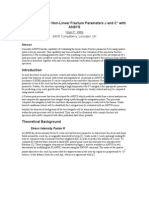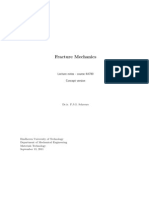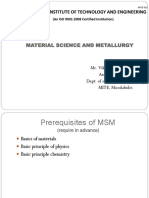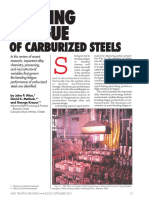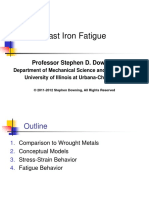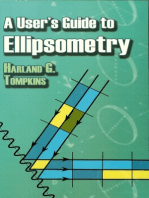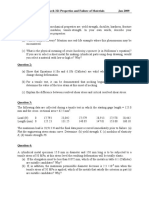100%(1)100% found this document useful (1 vote)
911 viewsConcept Check Answers Ch6
Concept Check Answers Ch6
Uploaded by
Ruben Abreu1) Elastic deformation is time-independent and nonpermanent, anelastic deformation is time-dependent and nonpermanent, while plastic deformation is permanent.
2) Material B will experience the greatest percent area reduction since it has the highest strain at fracture and is most ductile. Material D is the strongest because it has the highest yield and tensile strengths. Material E is the stiffest because it has the highest elastic modulus.
3) The initial linear portions of the tensile and compressive stress-strain curves will be the same, but beyond the elastic region the compression curve will lie above the tension curve due to differences in cross-sectional area under tension and compression. The compression curve will not display a maximum
Copyright:
© All Rights Reserved
Available Formats
Download as PDF, TXT or read online from Scribd
Concept Check Answers Ch6
Concept Check Answers Ch6
Uploaded by
Ruben Abreu100%(1)100% found this document useful (1 vote)
911 views5 pages1) Elastic deformation is time-independent and nonpermanent, anelastic deformation is time-dependent and nonpermanent, while plastic deformation is permanent.
2) Material B will experience the greatest percent area reduction since it has the highest strain at fracture and is most ductile. Material D is the strongest because it has the highest yield and tensile strengths. Material E is the stiffest because it has the highest elastic modulus.
3) The initial linear portions of the tensile and compressive stress-strain curves will be the same, but beyond the elastic region the compression curve will lie above the tension curve due to differences in cross-sectional area under tension and compression. The compression curve will not display a maximum
Copyright
© © All Rights Reserved
Available Formats
PDF, TXT or read online from Scribd
Share this document
Did you find this document useful?
Is this content inappropriate?
1) Elastic deformation is time-independent and nonpermanent, anelastic deformation is time-dependent and nonpermanent, while plastic deformation is permanent.
2) Material B will experience the greatest percent area reduction since it has the highest strain at fracture and is most ductile. Material D is the strongest because it has the highest yield and tensile strengths. Material E is the stiffest because it has the highest elastic modulus.
3) The initial linear portions of the tensile and compressive stress-strain curves will be the same, but beyond the elastic region the compression curve will lie above the tension curve due to differences in cross-sectional area under tension and compression. The compression curve will not display a maximum
Copyright:
© All Rights Reserved
Available Formats
Download as PDF, TXT or read online from Scribd
Download as pdf or txt
100%(1)100% found this document useful (1 vote)
911 views5 pagesConcept Check Answers Ch6
Concept Check Answers Ch6
Uploaded by
Ruben Abreu1) Elastic deformation is time-independent and nonpermanent, anelastic deformation is time-dependent and nonpermanent, while plastic deformation is permanent.
2) Material B will experience the greatest percent area reduction since it has the highest strain at fracture and is most ductile. Material D is the strongest because it has the highest yield and tensile strengths. Material E is the stiffest because it has the highest elastic modulus.
3) The initial linear portions of the tensile and compressive stress-strain curves will be the same, but beyond the elastic region the compression curve will lie above the tension curve due to differences in cross-sectional area under tension and compression. The compression curve will not display a maximum
Copyright:
© All Rights Reserved
Available Formats
Download as PDF, TXT or read online from Scribd
Download as pdf or txt
You are on page 1of 5
Chapter 6
Mechanical Properties of Metals
Concept Check 6.1
Question: Cite the primary differences between elastic, anelastic, and plastic
deformation behaviors.
Answer: Elastic deformation is time-independent and nonpermanent, anelastic
deformation is time-dependent and nonpermanent, while plastic deformation is permanent.
Concept Check 6.2
Questions: Of those metals listed in Table 6.3,
(a) Which will experience the greatest percent reduction in area? Why?
(b) Which is the strongest? Why?
(c) Which is the stiffest? Why?
Table 6.3 Tensile stress-strain data for several hypothetical metals to be used with
Concept Checks 6.2 and 6.4
Yield Tensile Strain Fracture Elastic
Strength Strength at Strength Modulus
Material (MPa) (MPa) Fracture (MPa) (GPa)
A 310 340 0.23 265 210
B 100 120 0.40 105 150
C 415 550 0.15 500 310
D 700 850 0.14 720 210
E Fractures before yielding 650 350
Answers:
(a) Material B will experience the greatest percent area reduction since it has the highest
strain at fracture, and, therefore is most ductile.
(b) Material D is the strongest because it has the highest yield and tensile strengths.
(c) Material E is the stiffest because it has the highest elastic modulus.
Concept Check 6.3
Question: Make a schematic plot showing the tensile engineering stressstrain behavior
for a typical metal alloy to the point of fracture. Now superimpose on this plot a schematic
compressive engineering stress-strain curve for the same alloy. Explain any differences between
the two curves.
Answer: The schematic stress-strain graph on which is plotted the two curves is shown
below.
The initial linear (elastic) portions of both curves will be the same. Otherwise, there are three
differences between the two curves which are as follows:
(1) Beyond the elastic region, the tension curve lies below the compression one. The
reason for this is that, during compression, the cross-sectional area of the specimen is
increasingthat is, for two specimens that have the same initial cross-sectional area (A
0
), at some
specific strain value the instantaneous cross-sectional area in compression will be greater than in
tension. Consequently, the applied force necessary to continue deformation will be greater for
compression than for tension; and, since stress is defined according to Equation 6.1 as
=
F
A
0
the applied force is greater for compression, so also will the stress be greater (since A
0
is the same
for both cases).
(2) The compression curve will not display a maximum inasmuch as the specimen tested
in compression will not experience neckingthe cross-sectional area over which deformation is
occurring is continually increasing for compression.
(3) The strain at which failure occurs will be greater for compression. Again, this
behavior is explained by the lack of necking for the specimen tested in compression.
Concept Check 6.4
Question: Of those metals listed in Table 6.3, which is the hardest? Why?
Answer: Material D is the hardest because it has the highest tensile strength.
You might also like
- Solution Manual Defo and Fracture Mech oDocument162 pagesSolution Manual Defo and Fracture Mech ocastorNo ratings yet
- Mech 285 True or FalseDocument18 pagesMech 285 True or FalseKayleigh RobotnikNo ratings yet
- Individual Psychology Case AnalysisDocument7 pagesIndividual Psychology Case AnalysisDaniella Jhane CanaonNo ratings yet
- Alcoa Aluminium Alloy 6262Document2 pagesAlcoa Aluminium Alloy 6262Paul OnionsNo ratings yet
- HW 5 2010 SolutionsDocument7 pagesHW 5 2010 SolutionsArlindo Lopes Faria100% (1)
- Martensite FormationDocument13 pagesMartensite FormationMatteo1980No ratings yet
- Three Point Bending Test Research of Carbon FibreDocument3 pagesThree Point Bending Test Research of Carbon FibrekishoreNo ratings yet
- Introduction To Materials Science and Engineering Prof. Rajesh Prasad Department of Applied Mechanics Indian Institute of Technology, DelhiDocument9 pagesIntroduction To Materials Science and Engineering Prof. Rajesh Prasad Department of Applied Mechanics Indian Institute of Technology, DelhiRakesh Choudhary100% (1)
- HighStrainRate Recommended Procedure PDFDocument30 pagesHighStrainRate Recommended Procedure PDFSivaraman VisvanathanNo ratings yet
- Evaluation of The Non-Linear Fracture Parameters J and C With ANSYSDocument11 pagesEvaluation of The Non-Linear Fracture Parameters J and C With ANSYSPeti KovácsNo ratings yet
- Diffusion in Solids PDFDocument72 pagesDiffusion in Solids PDFrantiana27100% (1)
- Vortex Dynamics (PDFDrive)Document325 pagesVortex Dynamics (PDFDrive)amrif89No ratings yet
- Chapter 2Document59 pagesChapter 2Temesgen Zeleke100% (1)
- Liu - Fatigue Crack Propagation and Applied Stress Range - An Energy ApproachDocument7 pagesLiu - Fatigue Crack Propagation and Applied Stress Range - An Energy ApproachDavid C HouserNo ratings yet
- Topics in Mechanical Behavior of Materials: DislocationsDocument13 pagesTopics in Mechanical Behavior of Materials: DislocationsAman Kumar VermaNo ratings yet
- David R Gaskell and David E Laughlin IntDocument5 pagesDavid R Gaskell and David E Laughlin IntAyesha MasoodNo ratings yet
- Sir Alan Cottrell and The Dislocation Mechanics of FracturingDocument11 pagesSir Alan Cottrell and The Dislocation Mechanics of FracturingSaurabh ShashankNo ratings yet
- Chapter-4 Mechanical Testing 08-06-2014Document21 pagesChapter-4 Mechanical Testing 08-06-2014safeer ahmadNo ratings yet
- (Dislocations in Solids 14) John Hirth (Eds.) - A Tribute To F.R.N. Nabarro (2008, Elsevier Science)Document551 pages(Dislocations in Solids 14) John Hirth (Eds.) - A Tribute To F.R.N. Nabarro (2008, Elsevier Science)Hariom PrakashNo ratings yet
- Fracture MechanicsDocument187 pagesFracture MechanicsLuis Alberto Ruiz PestañaNo ratings yet
- Model Question Paper ME010 304 Metallurgy and Material ScienceDocument2 pagesModel Question Paper ME010 304 Metallurgy and Material Scienceabijith_mexxNo ratings yet
- Chapter 5b Crystal Imperfections DislocationsDocument94 pagesChapter 5b Crystal Imperfections DislocationsSayantan DexNo ratings yet
- Assignment 2 SolutionsDocument9 pagesAssignment 2 SolutionsDoms DominguezNo ratings yet
- Chapter 4 EpfmDocument23 pagesChapter 4 Epfmwandee2393No ratings yet
- Circle Grid Marking and Measurement and FLD PDFDocument10 pagesCircle Grid Marking and Measurement and FLD PDFwulfgang66No ratings yet
- Stress-Strain Curve 3. Short Term Mechanical PropertiesDocument183 pagesStress-Strain Curve 3. Short Term Mechanical PropertiesManprita BasumataryNo ratings yet
- Curve Determination: Standard Test Method ForDocument16 pagesCurve Determination: Standard Test Method ForNilton SantillanNo ratings yet
- Theoretical Calculation of Strain Hardening ExponentDocument4 pagesTheoretical Calculation of Strain Hardening ExponentRavi TejaNo ratings yet
- Welding PDFDocument6 pagesWelding PDFNavneet ChaubeyNo ratings yet
- Mangalore Institute of Technology and Engineering: Material Science and MetallurgyDocument203 pagesMangalore Institute of Technology and Engineering: Material Science and MetallurgyNISHAANTH S 1861462No ratings yet
- Lec 11 - Materials Selection - Case Studies 02Document19 pagesLec 11 - Materials Selection - Case Studies 02jabir hossainNo ratings yet
- 13 ThermoelasticityDocument18 pages13 ThermoelasticityaderancNo ratings yet
- MECH2419 Test 2015 SolutionDocument5 pagesMECH2419 Test 2015 SolutionYau Chung Hin HarrisNo ratings yet
- nb-3216.2 MIT 2007Document23 pagesnb-3216.2 MIT 2007adel_izadbakhshNo ratings yet
- CH 10Document23 pagesCH 10Amelia RahmawatiNo ratings yet
- Faraday Acceleration FieldDocument6 pagesFaraday Acceleration FieldDiego Betancourt100% (1)
- Ah PDFDocument110 pagesAh PDFrocktallicaNo ratings yet
- Stress PDFDocument13 pagesStress PDF9966197483No ratings yet
- Analysis of Stress Concentration Factor in Bolted Joint Using Finite Element MethodDocument9 pagesAnalysis of Stress Concentration Factor in Bolted Joint Using Finite Element Methodvj2011100% (1)
- CH 9Document6 pagesCH 9rammech85No ratings yet
- Metal Oxides Semiconductor CeramicsDocument14 pagesMetal Oxides Semiconductor Ceramicsumarasad1100% (1)
- Module-1: Tensor Algebra: Lecture-1: Introduction To Continuum MechanicsDocument3 pagesModule-1: Tensor Algebra: Lecture-1: Introduction To Continuum MechanicsroysiddarthNo ratings yet
- BaTiO3 Ceramica ArtigoDocument7 pagesBaTiO3 Ceramica ArtigoLays de AraújoNo ratings yet
- MIT2 080JF13 Lecture11Document21 pagesMIT2 080JF13 Lecture11combatps1No ratings yet
- Fracture MechanicsDocument34 pagesFracture Mechanicsraees ahmadNo ratings yet
- Chapter 11 BendingDocument27 pagesChapter 11 BendingSofwan JuewekNo ratings yet
- Bending Fatigue of Carburized SteelDocument9 pagesBending Fatigue of Carburized SteelChin-Min YangNo ratings yet
- 2 Cast Iron FatigueDocument47 pages2 Cast Iron FatigueBruno BrepohlNo ratings yet
- Ques202 295bon2mcDocument13 pagesQues202 295bon2mcMuhammad HaneefNo ratings yet
- Laplace Table PDFDocument2 pagesLaplace Table PDFSnehith Reddy KathiNo ratings yet
- 07 Fracture 1-18 PDFDocument18 pages07 Fracture 1-18 PDFDepi WayatiNo ratings yet
- Phys Question BankDocument23 pagesPhys Question BankSai SriramNo ratings yet
- AM2007 ChabocheABSTDocument2 pagesAM2007 ChabocheABSTRadim HalamaNo ratings yet
- Damage Mechanics in Metal Forming: Advanced Modeling and Numerical SimulationFrom EverandDamage Mechanics in Metal Forming: Advanced Modeling and Numerical SimulationRating: 4 out of 5 stars4/5 (1)
- Electron Microscopy: Principles and FundamentalsFrom EverandElectron Microscopy: Principles and FundamentalsS AmelinckxNo ratings yet
- Probabilistic Physics of Failure Approach to Reliability: Modeling, Accelerated Testing, Prognosis and Reliability AssessmentFrom EverandProbabilistic Physics of Failure Approach to Reliability: Modeling, Accelerated Testing, Prognosis and Reliability AssessmentNo ratings yet
- Processing and Properties of Advanced Ceramics and Composites IVFrom EverandProcessing and Properties of Advanced Ceramics and Composites IVNo ratings yet
- CH 06Document5 pagesCH 06Mert TurfandaNo ratings yet
- Assignment 1 Mech 321 Properties and Failure of Materials Jan 2009Document2 pagesAssignment 1 Mech 321 Properties and Failure of Materials Jan 2009DSGNo ratings yet
- Mechanical Properties of Solids - WatermarkDocument14 pagesMechanical Properties of Solids - Watermarknetrikasingh25No ratings yet
- Documentation - A4 Rhino Presentation For Print by GoaShapeDocument12 pagesDocumentation - A4 Rhino Presentation For Print by GoaShapeJose Luis Merino ParraNo ratings yet
- Leadership ManagementDocument17 pagesLeadership ManagementLugo Marcus100% (2)
- Julkipli Et Al. 2022. Optimization of Cephalosporin C Acylase Immobilization Using Crosslinked Enzyme Aggregates TechniqueDocument11 pagesJulkipli Et Al. 2022. Optimization of Cephalosporin C Acylase Immobilization Using Crosslinked Enzyme Aggregates Techniquejulkipli amsyirNo ratings yet
- Campbell Biology Chapter 4: Terms in This SetDocument2 pagesCampbell Biology Chapter 4: Terms in This SetAngelene PelayoNo ratings yet
- Cellular AberrationDocument73 pagesCellular AberrationKim AmadoNo ratings yet
- 12V DC Intrinsically Safe Power Supply: Technical Datasheet Technical DatasheetDocument2 pages12V DC Intrinsically Safe Power Supply: Technical Datasheet Technical DatasheetProcurement PardisanNo ratings yet
- 206-05 Travão de Mão E Mecanismo de AccionamentoDocument2 pages206-05 Travão de Mão E Mecanismo de AccionamentokassioNo ratings yet
- Heat Transfer System FlushingDocument2 pagesHeat Transfer System FlushingDANIEL ZORRONo ratings yet
- Enamel and Dentin BondingDocument9 pagesEnamel and Dentin Bondinghelmuthw0207No ratings yet
- 2019 Event Entertainment Guide: For Events Across TheDocument34 pages2019 Event Entertainment Guide: For Events Across Thesinner306No ratings yet
- K-2 Teacher's Guide: English - Unit 2Document58 pagesK-2 Teacher's Guide: English - Unit 2arol1313No ratings yet
- Multiple Choice Enzymes Plant and Animal NutritionDocument44 pagesMultiple Choice Enzymes Plant and Animal Nutritionliufanjing07No ratings yet
- UntitledDocument74 pagesUntitledRonhielyn AlbisNo ratings yet
- Full Download McGraw-Hill’s Taxation of Individuals and Business Entities 2019 Edition Brian C Spilker Et Al. PDF DOCXDocument66 pagesFull Download McGraw-Hill’s Taxation of Individuals and Business Entities 2019 Edition Brian C Spilker Et Al. PDF DOCXhoatkifung100% (3)
- Introduction To SurgeryDocument45 pagesIntroduction To SurgeryBea Marie Eclevia50% (2)
- Pakistan'S Tourism Potential: Report of Nips Webinar OnDocument16 pagesPakistan'S Tourism Potential: Report of Nips Webinar OnWALEED TAHIRNo ratings yet
- Science 4-Q4-SLM7Document13 pagesScience 4-Q4-SLM7Ana ConseNo ratings yet
- T Tal Plant: UDC 6300 Process ControllerDocument8 pagesT Tal Plant: UDC 6300 Process ControllerisctomaslopezNo ratings yet
- Los Angeles: Luka Arapovic 3.eDocument19 pagesLos Angeles: Luka Arapovic 3.eLuka ArapovićNo ratings yet
- MemorandumDocument4 pagesMemorandumapi-254991400No ratings yet
- Class 12 Unit 1 Physics NotesDocument24 pagesClass 12 Unit 1 Physics Notespurnimaraghu8974No ratings yet
- Part Catalog Mf5709Document595 pagesPart Catalog Mf5709Dedy setiawan100% (1)
- Report GliderDocument29 pagesReport GliderAmirul Haqim Mohd JoraNo ratings yet
- Den DR OlogyDocument436 pagesDen DR OlogyCBSE UGC NET EXAMNo ratings yet
- John J. Collins (1982) - The Apocalyptic Technique. Setting and Function in The Book of Watchers. The Catholic Biblical Quarterly 44.1, Pp. 91-111Document22 pagesJohn J. Collins (1982) - The Apocalyptic Technique. Setting and Function in The Book of Watchers. The Catholic Biblical Quarterly 44.1, Pp. 91-111Olestar 2023-06-27No ratings yet
- Rate of ReactionDocument49 pagesRate of Reactionjt100% (1)
- Sfia Tech Spec 2015 Updated 8.14.15Document97 pagesSfia Tech Spec 2015 Updated 8.14.15ZebNo ratings yet
- Ib AssignmentDocument3 pagesIb AssignmentLHNo ratings yet
- Definition of ERP (Enterprise Resource Planning)Document12 pagesDefinition of ERP (Enterprise Resource Planning)Harish SrinivasNo ratings yet









